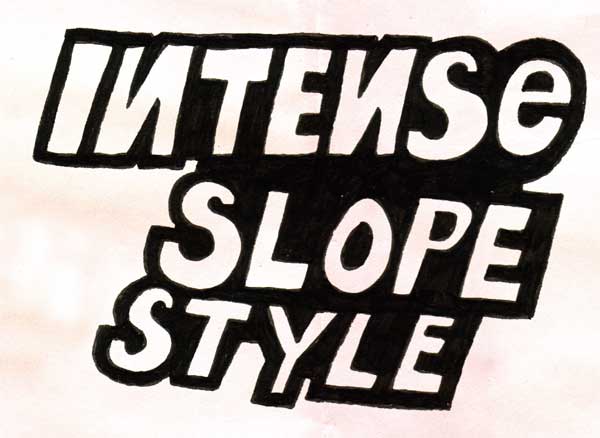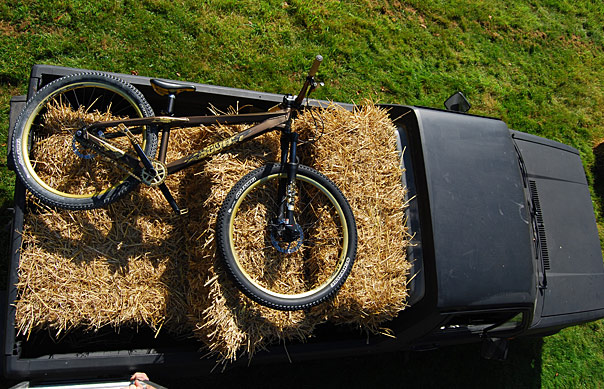
Bike Test: INTENSE 6.6 SS
The Intense Slopestyle (SS) sits in between the Tracer (a 5.5–6” travel Enduro bike) and the soon to be re–released Uzzi (a seven inch bike for some bigger terrain). Intense are pretty clear about the SS, as the company point out it is “built to perform in the park environment giving you the ability to throw tricks and fly over built lines with ease.”.
Seeing as the only throwing I’d be doing would be of a lumpy nature if I attempted some of the shit riders are doing in the North American or European bike parks, but also bearing in mind Slope Style isn’t exactly at the cutting edge of UK riding right now, where then does the trail lead for the SS? Chain Reaction manager Nigel Page was on the blower last week with the same question. “What bike for the team riders in the Megavalanche? Tracer or SS?” I didn’t really know how to answer the question, the Tracer is a great bike slightly out of its depth on big Alpine rocks, but Camellini is an awesome rider who could overcome this. The SS on the other hand tips in the other side of 30lb and we both agreed it possibly needed a slightly slacker head angle for the high–speed sections. This particular bike is the very one raced by Steve Bancroft (Ride BMX editor) in the Mega last year. It’s a lightweight build essentially featuring Easton wheelset, XTR chainset and Sram gearing. The Fox 36’s balance the bike up front giving the bike on average six inches of travel. Half inch more on the back.
WHAT IS IT FOR?
It’s fair to say that the SS has become known as either a long travel trail bike or a mini downhill bike in this country. This comes from a variety of discussions over the past six months since it landed here in Monmouth. Whilst many people have it labelled as the comfortable option for the Mega, I still don’t know anyone yet who has been sloping on it lets put it that way. One rider phoned the office today considering getting one as his new bike for ‘gravity based riding and doing massive jumps’ as he put it. Hmm, none of this talk really adds up to its original mission it seems, and the only specialism it might have ain’t really been put to the test on. This bothers me but I’m thinking…who/where?
WHAT WE DID WITH IT
There’s only so much time you can have in the air. Only so much time you can have on a bike too it seems. Who exactly is doing these nine runs of a four–minute track with a twenty–minute uplift? Thirty minutes riding, three hours driving. Are you mental? We took it down the local, 10 two–minute mellow ones an hour, bit of nonsense, load of banter and plenty of time to chat with the ladies with the Cavalier King Charles trooping out for walkies. It’s a fun bike for shaping it up over the jumps, it’s lively, balanced, and covers the ground sharpish. Unweighting over jumps it doesn’t deal you any surprises and takes up aggressive hits onto transitions comfortably. One particular track we have here carves big arcs, dipping into compressions before dropping off onto a road. It then follows off–camber where there’s the need to pick up over roots, squash and pre–jump some fly–offs and carve again into some tight corners. It’s flowing and this bike flows, it’s an absolute scream. I love the fact you can totally dive into the deeper, sharper corners with massive confidence and I love the fact that it’s so manoeuvrable.





JUST GO AND BUY ONE THEN?
Well yes. Except the market is full of similar complete builds with equal if not better performance…and at a fraction of the cost. Take the Specialized SX Trail, not massively dissimilar to Berrecloth’s which you can get for not that much more complete featuring Avid Elixir, Sram X0, Stlyo cranks and a pair of Van 36’s. A Cane Creek shock would make this bike because one of its weaknesses was dealing was square edge hits – continuous exposed root at higher speeds than what it would encounter hanging out in the park style. I also felt there was a need to manage rider pressure on the front wheel to maintain shape and balance in corners. A number of factors might be at work here, but there were points where the SS had less than perfect steering. Take care to get the standard Fox with the correct set–up. Riders shouldn’t buy this bike thinking it’s going to be faster at mellower downhills than a downhill bike because it’s not. If you’re into riding a bike downhill as fast as possible and that’s all that you do then you will have much more on your hands in something like an Intense Socom. It will go more places quicker. If on the other hand you want to hang out, do some jumps, do a bit of DH sectioning, some uplift, the odd race and be able to possibly push a bike downhill to its limit then the SS is well worth a look. In fact stick a set of lightweight wheels and tyres and you’d manage the mid week ride pretty comfortably too. The Intense SS has all those un–measurables related to buying a bike from the Californian company, the kind of things that matter to a lot of people. There’s a really nice feel about it when you’re riding it. I can see it would be even better in a place like Whistler. In the UK though? I think it could be more. Imagining here a mini version of the unquestionably smart looking M6. Six to seven inch, just over the thirty pound mark…a mini M6 with all the stealth gustiness that it exudes. A mini downhill bike essentially. The SS then, a good craic that can, and no doubt will, be improved. As one of the guys in the office put it. “The SS is missing a trick by trying to be something it’s not.”






